Are you seeking sources of royalty free images to amplify the visual appeal of your WordPress blog? It’s a critical consideration as research shows that blog posts with images get 94% more views than those without. However, navigating the realm of copyright regulations can be challenging.
As the saying goes, “A picture is worth a thousand words.” This holds true, especially in the digital landscape, where visual content reigns supreme. But finding images that are not just visually captivating but also legally safe to use can be a hurdle.
Benefits of Royalty Free Images:

- Legal Compliance: Royalty-free images are licensed for specific uses without the need for recurring payments. This allows you to avoid legal issues related to copyright infringement.
- Cost-Effectiveness: Many royalty-free image repositories offer affordable or free access to a vast library of high-quality visuals. This is especially beneficial for bloggers and small businesses working with limited budgets.
- Diverse Selection: These platforms host a wide array of images catering to various themes, styles, and subjects. You can find everything from landscapes and portraits to abstract art, ensuring you find the perfect match for your content.
- Enhanced Engagement: Visual content significantly enhances user engagement. With compelling images, your blog posts become more captivating and shareable, attracting and retaining more readers.
- Customization Options: Royalty-free images often come with the flexibility to modify, crop, or adapt them to suit your blog’s style or messaging without violating usage terms.
- Time-Saving: Rather than creating your visuals, royalty-free images provide a time-efficient solution. You can quickly find and integrate high-quality visuals into your posts, saving valuable time in the content creation process.
- Reduced Risk: Using royalty-free images mitigates the risk of unintentional copyright violations. It offers peace of mind, allowing you to focus on creating engaging content without worrying about legal repercussions.
Top Royalty Free Image Providers:
1. FreeImages
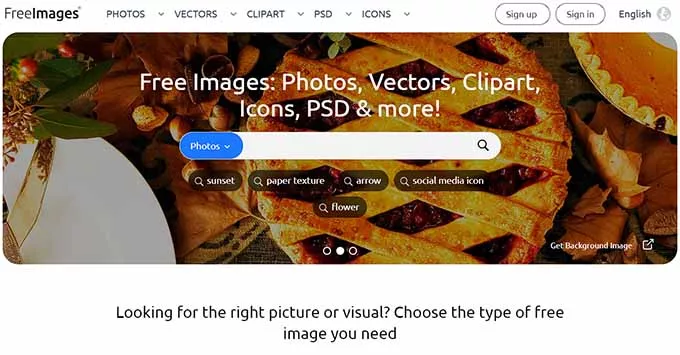
FreeImages is an established platform renowned for its vast collection of royalty-free images, catering to diverse visual needs. Originally launched as Stock.XCHNG in 2001, the platform underwent a rebranding in 2014, becoming FreeImages. Over the years, it has amassed millions of high-quality stock photos, vectors, icons, and more, serving as a go-to resource for bloggers, content creators, and businesses seeking visuals for various purposes.
Pros:
- Extensive Library: FreeImages boasts a vast and diverse collection of high-quality images suitable for blogs, presentations, newsletters, and more.
- User-Friendly Interface: Its intuitive interface simplifies image searches through a search bar and categorized browsing, facilitating a seamless selection process.
- Free Downloads: Users can access and download images without incurring any charges, making it an attractive option for those on a budget.
- Supplementary Features: The platform offers extras like an image lightbox, filtering options, multiple download choices, and user engagement features like comments and ratings.
Cons:
- Limited Advanced Features: While user-friendly, FreeImages might lack some advanced functionalities and comprehensive editing options found in premium image repositories.
- Quality Variances: The image quality can vary, and locating specific niche content within the extensive library might pose challenges.
2. Pixabay
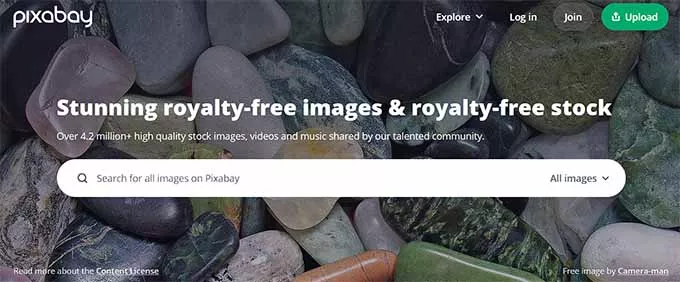
Pixabay stands as a prominent hub for royalty-free images licensed under CC-0, offering users a treasure trove of visuals spanning various categories and tags. Its user-friendly interface simplifies the quest for the perfect images, employing an advanced search feature that expedites the process.
The platform boasts a vast library comprising over 2.7 million high-quality, royalty-free resources, including images, videos, and audio files. This expansive collection aims to enhance the appeal and engagement of blog posts, catering to diverse content needs.
Pixabay’s versatility extends to its array of download options, providing users with multiple sizes and resolutions suited for website integration. With its rich repository and accommodating download choices, Pixabay emerges as a prime destination for bloggers seeking captivating visuals to enrich their WordPress blog content.
Pros:
- Extensive Collection: Pixabay hosts an extensive array of over 2.7 million royalty-free images, videos, and audio files, catering to diverse content needs.
- Advanced Search: Its advanced search functionality facilitates swift and efficient image discovery based on specific preferences and requirements.
- Download Options: The platform offers various download choices, allowing users to access images in different sizes and resolutions for optimal website integration.
Cons:
- Quality Assurance: While Pixabay maintains high standards, occasional variations in image quality might be encountered within its vast library.
- Competition: Due to its popularity, finding unique or niche-specific visuals might prove challenging amidst the extensive collection.
Learn about website design trends here.
3. Unsplash
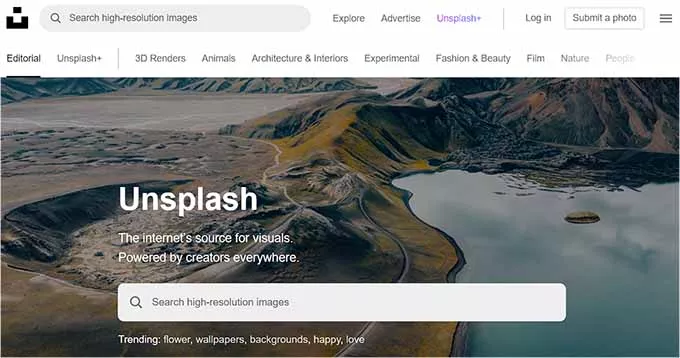
Unsplash stands tall as a widely recognized platform renowned for its extensive collection of high-quality, royalty-free, CC-0 licensed, and public domain images. Its robust search feature empowers users to explore a diverse range of themes, from nature to office environments, facilitating swift image discovery.
The platform prides itself on a vast library, complete with an image lightbox and a commenting feature, fostering a thriving community of photographers who contribute regularly. This bustling community ensures a continuous influx of fresh and diverse visual content, enriching Unsplash’s repository.
Noteworthy among its features is the Google Chrome extension, offering users a delightful experience of encountering random images when opening new tabs. This feature enables easy downloads, allowing users to save these images directly to their computers.
Pros:
- Extensive Collection: Unsplash boasts an extensive array of high-quality, CC-0 licensed images across various themes, catering to diverse content requirements.
- Community Engagement: A vibrant community of photographers contributes regularly, ensuring a steady inflow of fresh and diverse visual content.
- Google Chrome Extension: The platform’s extension provides a delightful browsing experience, presenting users with random images on new tabs, facilitating easy downloads.
Cons:
- Inconsistent Image Quality: While Unsplash maintains high standards, variations in image quality might be encountered across its vast library due to community contributions.
- Overwhelming Choice: The abundance of images might overwhelm users, making it challenging to find niche-specific or unique visuals amidst the vast collection.
4. Vecteezy
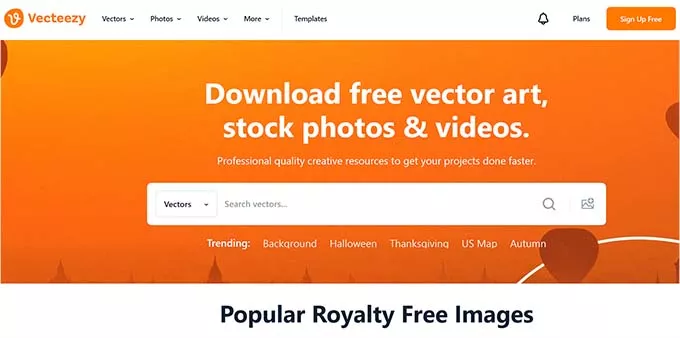
Vecteezy stands as a prominent platform offering an extensive array of stock vectors, icons, and graphics, available for both free and paid downloads. With a colossal library housing over 40 million files, Vecteezy ensures a seamless user experience coupled with flexible licensing options.
This user-friendly platform offers an online editor, eliminating the need for software downloads, allowing users to modify images conveniently within their browsers. Additionally, Vecteezy provides an API, empowering users to seamlessly integrate its rich content into their applications, simplifying the process of incorporating royalty-free images into WordPress websites.
Pros:
- Vast Collection: Vecteezy boasts an expansive library of over 40 million files, offering a wide range of vectors, icons, and graphics.
- User-Friendly: The platform’s intuitive interface makes it exceptionally easy to navigate, ensuring a hassle-free experience for users.
- Online Editor: Vecteezy’s online editing feature allows for convenient image modifications without the need for additional software.
Cons:
- Mixed Licensing: While many resources are available for free, certain premium assets may require payment, potentially limiting access to specific content.
- Varied Quality: The quality of assets may vary across the vast library, requiring users to sift through options to find the desired high-quality images.
5. Public Domain Pictures
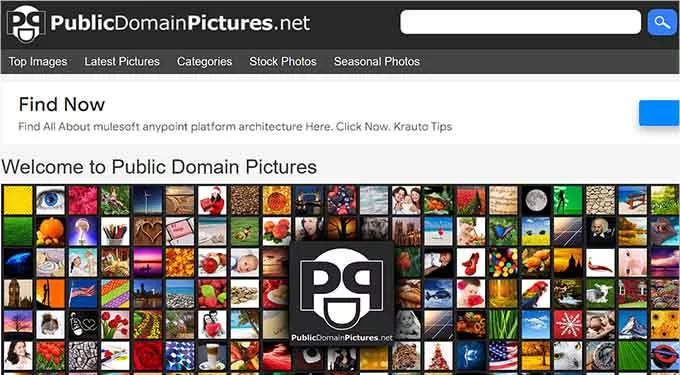
Public Domain Pictures stands as an impressive platform housing a vast collection of royalty-free images and photographs, serving as an invaluable resource for website imagery.
Pros:
- Search and Browse: Users can easily explore images using the search feature or by browsing through the platform’s diverse categories.
- Filtering Options: The platform offers multiple filtering options based on image size, orientation, colors, and more, facilitating a refined search experience.
- Flexible Downloads: Public Domain Pictures provides versatile download options, ensuring users can obtain images in various formats and sizes.
Cons:
- Quality Variance: The platform’s vast library may contain images of varying quality, necessitating careful selection to find high-quality visuals.
- Limited Attribution: While images are free to use for any purpose and don’t require attribution, the licensing terms may limit certain usage scenarios.
6. New Old Stock
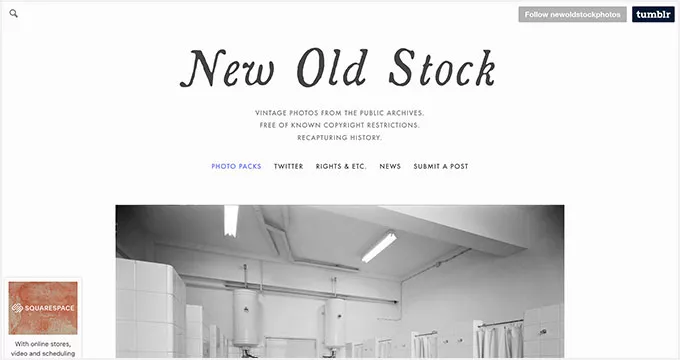
New Old Stock stands as an exceptional online repository featuring a captivating collection of meticulously curated vintage photographs that now reside within the public domain. Offering a unique glimpse into bygone eras, these images are a treasure trove for those seeking historical insights.
Pros:
- Curated Vintage Collection: The platform boasts a curated assortment of over 70,000 high-resolution vintage photos encompassing various themes such as people, landscapes, architecture, and everyday life.
- Advanced Search Feature: Users can easily navigate through the extensive collection using the platform’s advanced search feature, allowing for precise exploration based on specific themes or keywords.
- Historical Context: Many images come with detailed historical context, providing valuable information about the date, location, and background of the captured moments, enhancing their significance.
- User-Friendly Interface: New Old Stock offers a user-friendly interface, providing a seamless browsing experience with convenient lightbox functionality and flexible download options.
Cons:
- Limited Contemporary Content: Given its focus on vintage imagery, the platform may have limited contemporary visuals, which might not cater to users seeking modern or diverse image collections.
- Niche Appeal: The specialized collection of vintage photographs might have a niche appeal, making it suitable for specific thematic or historical projects rather than general visual needs.
7. Pickup Image
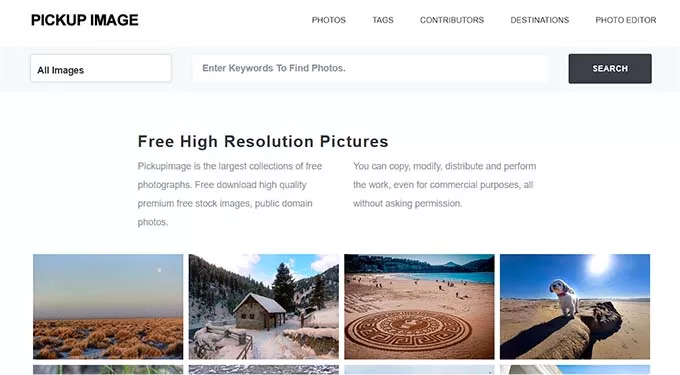
Dive into a treasure trove of visual delights with Pickup Image! This dynamic platform unveils a kaleidoscope of royalty-free photographs, images, and clipart, promising a seamless journey through a universe of stunning visuals. From vibrant snapshots capturing life’s myriad moments to meticulously curated clipart, it’s a gallery that caters to every creative whim.
Pros:
- Expansive Collection: Encompassing a diverse library, it offers an extensive range of visuals, ensuring ample choices across various themes and subjects.
- User-Friendly Interface: With an intuitive interface, its easy navigation and efficient search function simplify the hunt for specific images, saving valuable time.
- Categorized Organization: Sorting images into well-structured categories and tags enables swift and precise browsing, enhancing user experience.
Cons:
- Content Redundancy: The breadth of the collection might lead to occasional overlap with similar images found on other platforms, limiting exclusivity.
- Quality Assurance: Given the vast selection, maintaining consistent image quality might present challenges, impacting the overall reliability of the collection.
8. Public Domain Archive
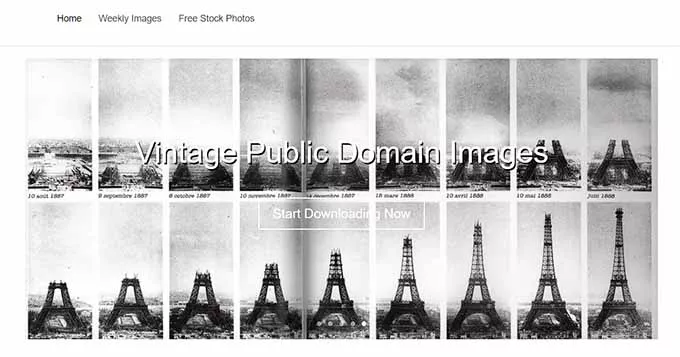
With a commitment to providing captivating visuals, Public Domain Archive curates a blend of modern and vintage photographs. Founded with a vision to offer unrestricted access to high-quality imagery, this platform sources content from various contributors worldwide. Boasting an array of categories and an efficient search feature, it aims to simplify the quest for the perfect visual element for diverse projects.
Pros:
- Diverse Imagery: Offering a blend of modern and vintage photographs, it caters to varied aesthetic preferences.
- User Engagement: Allowing users to comment on and rate images fosters a community-driven approach, aiding in discovering relevant content.
Cons:
- Limited Organizational Features: While categories exist, the platform might benefit from enhanced organizational tools for a more refined search experience.
- Content Volume: The volume of images, while diverse, might not match larger stock image platforms, potentially limiting specific niche selections.
9. SplitShire

SplitShire stands as a treasure trove for creatives seeking unique and high-quality images. With an impressive collection exceeding 20,000 visuals, this platform hosts an array of diverse photographs catering to various niches. Its mosaic view or tag-filtering system offers an intuitive means of navigating through the extensive collection. What sets SplitShire apart is its commitment to offering visuals that spark inspiration and resonate with a broad spectrum of artistic endeavors.
Pros:
- Diverse Collection: With over 20,000 images, the library offers a broad spectrum of visuals across various themes and subjects.
- User-Friendly Interface: The tags filter and mosaic view enhance browsing ease, enabling quick searches and exploration.
Cons:
- Limited Advanced Features: Compared to some other platforms, it might lack more sophisticated features for in-depth image searches or customization.
- Smaller Library: While extensive, the library size might be smaller than some of the larger stock image repositories.
10. LibreShot
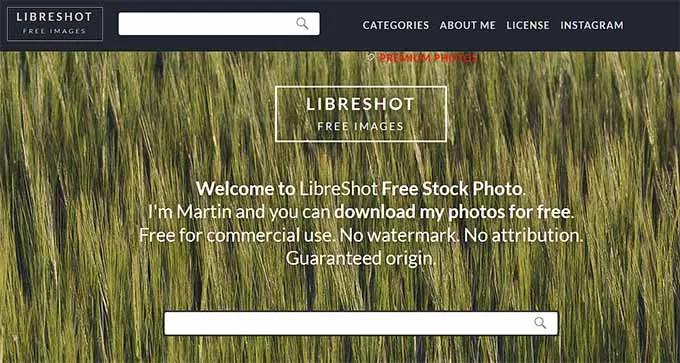
LibreShot is a sanctuary for those in search of a vast repository of stock photos and videos. Its collection of over 1 million images spans an array of subjects, encompassing everything from captivating landscapes to vivid portraits. Whether you’re in need of compelling visuals for personal or professional projects, LibreShot offers an easy-to-use interface that facilitates efficient browsing. Beyond the extensive free offerings, the platform also features premium images, catering to diverse needs and preferences.
Pros:
- Extensive Collection: With over 1 million images and videos, LibreShot offers a vast array of visuals to suit various needs.
- Advanced Search Options: The platform’s advanced search functionality enhances the efficiency of finding specific content.
Cons:
- Mixed Quality: While the collection is vast, the varying quality of images might affect overall user satisfaction.
- Premium Images: The inclusion of premium images might limit the scope of completely free content.
11. Skitterphoto
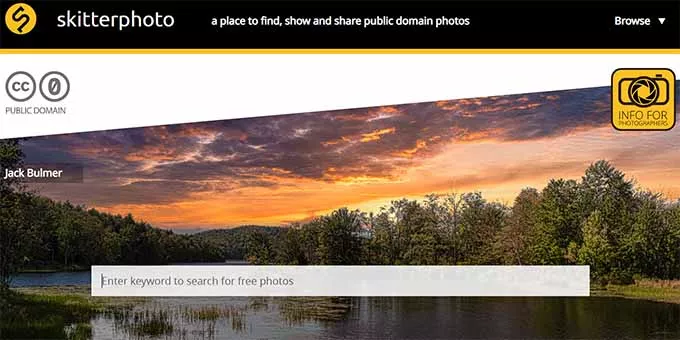
Skitterphoto presents a gallery of high-resolution, royalty-free images that dance under the CC0 public domain license. What sets this platform apart is its focus on less-common, more distinctive visuals captured by their in-house photographers. This uniqueness lends a fresh perspective, offering users an opportunity to discover and incorporate less mainstream yet captivating images into their projects. Skitterphoto’s user-friendly interface encourages exploration, fostering a space where creativity flourishes.
Pros:
- Unique Content: Specializing in less common and more unique photographs, Skitterphoto offers a refreshing departure from mainstream imagery.
- Adaptation Rights: Users have the liberty to modify and adapt images as needed for diverse creative purposes.
Cons:
- Limited Volume: The collection might not be as vast as some larger repositories.
- Niche Selection: It might not cater to specific niche requirements due to its focus on uniqueness.
12. StockSnap
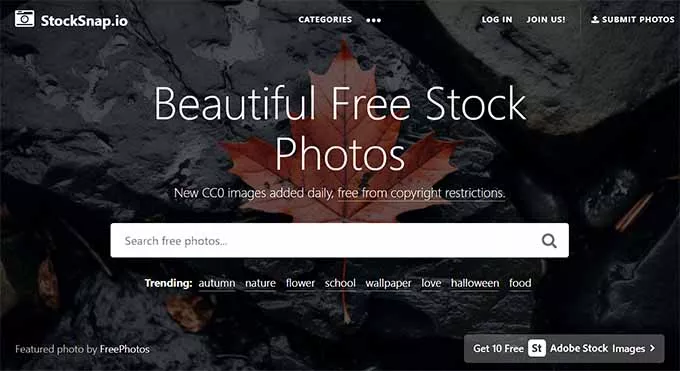
StockSnap.io stands tall as a meticulously curated repository housing over 2 million captivating, royalty-free, and CC0-licensed images. Each image is a testament to quality and diversity, ensuring that users find precisely what they seek. Navigating this extensive collection is a breeze, thanks to its intuitive search bar, well-categorized images, and tagging system. What makes StockSnap.io a go-to destination is its dedication to providing not just quantity but an array of striking visuals that cater to multifaceted creative needs.
Pros:
- Vast Library: With over 2 million images, StockSnap boasts an extensive collection to cater to diverse user needs.
- Ease of Use: The intuitive interface ensures seamless browsing, making it easy to find specific visuals.
Cons:
- Competitive Market: Given the competitive market, it might face challenges in offering completely unique content.
- Feature Limitations: Advanced features and customization options might be relatively limited compared to some premium platforms.
Conclusion:
Royalty-free images offer a versatile and accessible solution for individuals and businesses seeking high-quality visuals without the constraints of traditional copyright licenses. These images are available for use after a one-time purchase or often for free, granting users the right to utilize them in various projects without recurring fees. They provide a cost-effective way to enhance websites, blogs, marketing materials, presentations, and more, contributing to a visually appealing and professional aesthetic.
FAQs on Royalty Free Images:
Are royalty-free images free to use?
Not always. While some royalty-free images are free of charge, others might require a one-time payment or subscription fee for access. However, once acquired, they can generally be used multiple times without additional fees.
Can I modify royalty-free images?
Generally, yes. Many royalty-free images allow modification to suit your project’s needs. However, it’s essential to review the licensing terms of each image to ensure compliance with specific usage guidelines.
Do I need to credit the creator when using royalty-free images?
Requirements for attribution vary based on the image’s license. Some royalty-free images might require crediting the creator, while others don’t. It’s advisable to check the image’s licensing terms for specific attribution requirements.



